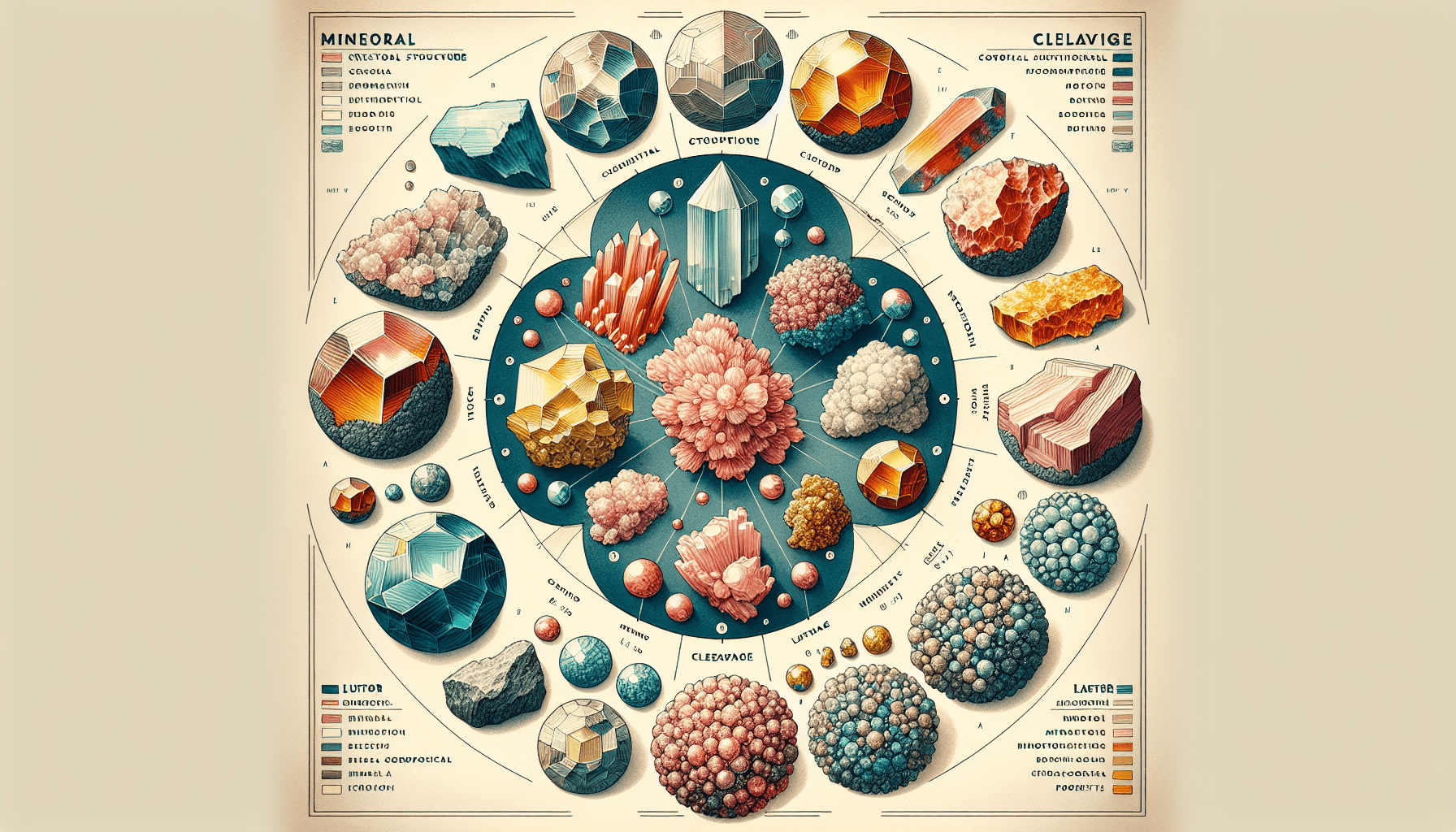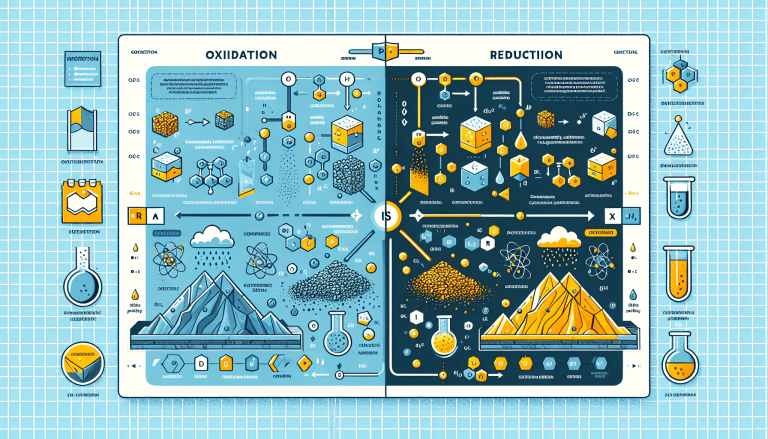Key Phrases To Remember When Studying Mineral Chemical Properties
So you’re diving into the fascinating world of studying mineral chemical properties. Understanding the composition and characteristics of minerals is no easy task, but fear not! We’ve got you covered with a collection of key phrases that will help you navigate this complex terrain. From crystalline structure to Mohs hardness scale, these phrases will equip you with a solid foundation to unlock the secrets of mineral chemistry. Get ready to uncover the wonders of the earth’s hidden treasures with these essential phrases at your disposal.

Composition
When studying minerals, it is important to start with understanding their composition. Minerals are made up of various chemical elements arranged in a specific way. These elements combine to form compounds, which give minerals their distinctive properties.
Elements
The basic building blocks of minerals are elements. Elements are substances that cannot be broken down into simpler substances by chemical means. There are over 90 naturally occurring elements, and each element has its unique set of properties. Some common elements found in minerals include oxygen, silicon, aluminum, calcium, and iron.
Compounds
Minerals are formed when elements bond together to create compounds. Compounds are substances composed of two or more elements chemically combined. The way in which elements combine to form compounds determines the properties of the minerals. For example, the combination of silicon and oxygen gives rise to a large group of minerals known as silicates.
Crystal Structure
The crystal structure of a mineral refers to the arrangement of atoms or ions within the mineral’s lattice. A unit cell is the smallest repeating unit of a crystal lattice. Lattice refers to the three-dimensional framework of the crystal structure. The symmetry of a mineral describes the repetitive pattern of its crystal structure.
Unit Cell
The unit cell is like a building block that is repeated in all directions to create the crystal lattice. It is the smallest repeating unit that represents the entire crystal structure. Different minerals have different unit cell shapes, such as cubic, hexagonal, or orthorhombic. The type of unit cell influences the physical properties of the mineral.
Lattice
The lattice is the three-dimensional arrangement of atoms or ions within a mineral. It forms a repeating pattern throughout the entire crystal structure. The lattice can have different shapes, such as cubic, tetragonal, or rhombohedral. The lattice determines the overall shape of the mineral and affects its physical and chemical properties.
Symmetry
Symmetry refers to the repeating pattern of the crystal structure. A mineral can exhibit different types of symmetry, such as cubic, hexagonal, or orthorhombic symmetry. The symmetry influences the external appearance of the mineral and can help in its identification.
Chemical Bonding
Chemical bonding is the process by which atoms or ions are held together within a mineral. There are three main types of chemical bonds found in minerals: ionic bonds, covalent bonds, and metallic bonds. Each type of bond results from different interactions between atoms or ions.
Ionic Bonds
Ionic bonds occur when one or more electrons are transferred from one atom to another, creating positively and negatively charged ions. These oppositely charged ions are attracted to each other and form a bond. Minerals with ionic bonds often have high melting points and are usually soluble in water.
Covalent Bonds
Covalent bonds occur when atoms share electrons to achieve a stable electron configuration. This sharing creates a strong bond between the atoms. Minerals with covalent bonds tend to have high hardness and are often insoluble in water.
Metallic Bonds
Metallic bonds occur when metal atoms share their valence electrons throughout the entire crystal lattice. This creates a “sea” of electrons that holds the metal ions together. Minerals with metallic bonds have high electrical and thermal conductivity and are typically malleable and ductile.
Mineral Formulas
Mineral formulas represent the chemical composition of a mineral. They use chemical symbols and subscripts to indicate the elements and their ratios within the compound. The formulas are based on the concept of electrical neutrality, where the overall charge of the mineral is balanced.
Chemical Symbols
Chemical symbols are abbreviations used to represent elements. Each element has a unique symbol, such as O for oxygen and Si for silicon. Mineral formulas use these symbols to indicate which elements are present in the compound.
Subscripts
Subscripts are used in mineral formulas to indicate the number of atoms of each element in the compound. For example, in the mineral quartz (SiO2), the subscript 2 indicates that there are two oxygen atoms for every one silicon atom. The subscripts help determine the chemical composition and structure of the mineral.
Electrical Neutrality
Minerals are electrically neutral, meaning they have a balanced overall charge. This is achieved by ensuring that the positive and negative charges of the atoms or ions in the mineral compound cancel each other out. The mineral formula reflects this electrical neutrality by indicating the proper ratio of elements.

Physical Properties
Minerals have a variety of physical properties that can help in their identification. These properties include color, luster, cleavage, and hardness.
Color
Color is one of the most obvious physical properties of a mineral. However, it is not always a reliable indicator of mineral identification, as some minerals can occur in a variety of colors. Color can be influenced by impurities or trace elements present in the mineral.
Luster
Luster refers to the way light is reflected from the surface of a mineral. Minerals can have metallic, non-metallic, or submetallic luster. Metallic minerals have a shiny appearance resembling metal, while non-metallic minerals can have various textures, such as glassy, silky, or dull.
Cleavage
Cleavage is the tendency of a mineral to break along smooth, flat surfaces. These surfaces are known as cleavage planes and are determined by the arrangement of atoms within the mineral. Different minerals can exhibit different types of cleavage, such as basal, prismatic, or cubic.
Hardness
Hardness is a measure of a mineral’s resistance to scratching. The Mohs scale of hardness is commonly used to rank minerals based on their hardness. Minerals with higher hardness can scratch minerals with lower hardness. For example, diamond, with a hardness of 10, can scratch any mineral on the scale.
Chemical Reactions
Minerals can undergo various chemical reactions, which can result in changes in their composition or properties. Some common chemical reactions involving minerals include acid reactions, oxidation reactions, and hydrolysis reactions.
Acid Reactions
Acid reactions occur when a mineral reacts with an acid, such as hydrochloric acid (HCl). This reaction can often result in the release of gas or the formation of a soluble compound. Acid reactions can be used as a test to identify certain minerals based on their reactivity with acids.
Oxidation Reactions
Oxidation reactions involve the addition of oxygen to a mineral, resulting in a change in its chemical composition. This can lead to the formation of oxides or hydroxides. Oxidation reactions can occur naturally over time, altering the appearance or properties of a mineral.
Hydrolysis Reactions
Hydrolysis reactions occur when a mineral reacts with water, leading to the breakdown of the mineral’s chemical structure. This can result in the formation of new minerals or the release of dissolved elements. Hydrolysis reactions can play a role in weathering and the formation of secondary minerals.
Mineral Groups
Minerals can be classified into different groups based on their chemical composition and structure. Some common mineral groups include silicates, carbonates, oxides, and sulfides.
Silicates
Silicates are the most abundant mineral group and are composed primarily of silicon and oxygen. They often contain other elements, such as aluminum, iron, calcium, or magnesium. Silicates have a wide range of properties and can form various crystal structures, including sheet-like structures or three-dimensional frameworks.
Carbonates
Carbonates are minerals composed of carbon, oxygen, and one or more metal elements, such as calcium or magnesium. They are commonly found in sedimentary rocks and often effervesce or fizz when they come into contact with acid.
Oxides
Oxides are minerals composed of oxygen and one or more metal elements. They can occur in a variety of forms, including as ores of valuable metals. Some common oxides include hematite (Fe2O3) and magnetite (Fe3O4), which are important sources of iron.
Sulfides
Sulfides are minerals composed of sulfur and one or more metal elements. They are often associated with hydrothermal or volcanic activity and can occur in metallic or non-metallic forms. Common sulfides include pyrite (FeS2) and galena (PbS).
Mineral Identification
Mineral identification involves using various tests and properties to determine the identity of a mineral. Some common methods for mineral identification include the streak test, specific gravity, fluorescence, and magnetism.
Streak Test
The streak test involves rubbing a mineral against a hard, unglazed porcelain plate to observe the color of the powder left behind. This can help differentiate minerals with similar colors but different streak colors. For example, hematite has a red streak, even though it appears black in its natural form.
Specific Gravity
Specific gravity is a measure of a mineral’s density compared to the density of water. It can be determined by weighing the mineral in air and then in water and calculating the ratio of the two weights. Specific gravity can help distinguish minerals with similar appearances but different densities.
Fluorescence
Fluorescence is the ability of a mineral to emit visible light when exposed to ultraviolet (UV) light. Some minerals exhibit bright, vivid colors under UV light, which can aid in their identification. Fluorescence is a unique property that is not present in all minerals.
Magnetism
Magnetism is a property exhibited by certain minerals that are attracted to a magnet. These minerals contain magnetic elements, such as iron, nickel, or cobalt, in their chemical composition. Magnetism can be a helpful tool in identifying specific minerals.
Formation and Classification
Minerals are formed through various geological processes and can be classified based on their formation. The three main types of minerals are igneous minerals, sedimentary minerals, and metamorphic minerals.
Igneous Minerals
Igneous minerals are formed through the cooling and solidification of molten rock, known as magma or lava. As the magma cools, minerals crystallize and solidify. Igneous minerals can have a range of compositions and can form both intrusive (slow cooling beneath the Earth’s surface) and extrusive (quick cooling on the Earth’s surface) rocks.
Sedimentary Minerals
Sedimentary minerals are formed from the accumulation and lithification of sediment. Sediment can be derived from weathered rocks, organic matter, or minerals precipitated from water. Over time, layers of sediment are compacted and cemented to form sedimentary rocks, which often contain a diverse variety of minerals.
Metamorphic Minerals
Metamorphic minerals are formed through the transformation of existing minerals under high temperature and pressure conditions. This process occurs within the Earth’s crust and is driven by tectonic forces. Metamorphic minerals can have unique properties and structures compared to their parent minerals.
Applications and Uses
Minerals have a wide range of applications and uses in various industries and everyday life. Some common applications include construction materials, gemstones, and industrial minerals.
Construction Materials
Many minerals are used as construction materials due to their strength, durability, and availability. For example, limestone is used as a building stone, gypsum is used in plasterboard, and granite is used for countertops and flooring. These minerals provide essential resources for the construction industry.
Gemstones
Certain minerals are prized for their beauty and are used as gemstones. Gemstones can be cut and polished to enhance their appearance and used in jewelry or decorative pieces. Examples of gemstones include diamond, emerald, ruby, and sapphire.
Industrial Minerals
Industrial minerals are minerals used in various industries for their physical or chemical properties. For example, talc is used in cosmetics, kaolin is used in ceramics, and bentonite is used in drilling fluids. Industrial minerals play a crucial role in manufacturing processes and the production of consumer goods.
In conclusion, studying mineral chemical properties involves understanding the composition of minerals, their crystal structure, chemical bonding, formulas, physical properties, chemical reactions, classification into mineral groups, identification methods, formation processes, and applications. By delving into these aspects, you can develop a comprehensive understanding of minerals and their significance in various fields.







